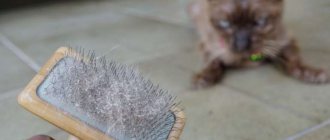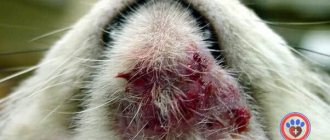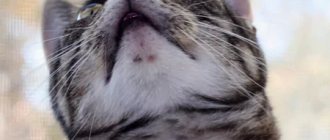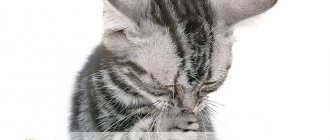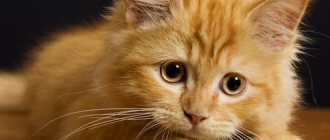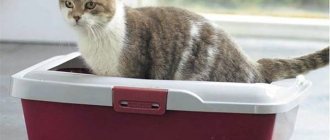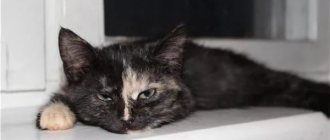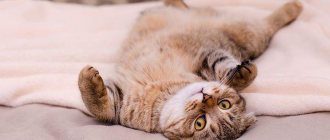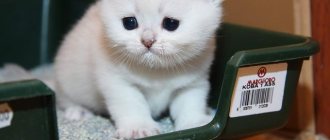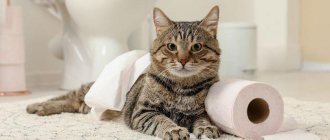Save the article:
In cats, like in humans, acne can appear on the skin - this is a dermatological disease that is not contagious to humans and is associated with improper functioning of the sebaceous glands. Acne in cats is quite rare, so acne noticed by the owner on the pet’s chin, belly, near the mouth, ears and base of the tail can cause quite a surprise. It is in these areas of the skin that the sebaceous glands are most numerous - a disruption of the metabolic process in the skin makes their functioning abnormal.
The pores of a cat's skin become clogged due to the accumulation of old epithelium stuck to the young skin cells by sebaceous secretions. Cat pimples can be white or black depending on whether the sebaceous plug is inside or outside the pore.
Since the process does not always develop into pathology, the phenomenon of self-healing takes place. But when pathogenic microbes get into the pores, the pet’s health faces problems: even the behavior of the animal shows how uncomfortable it is. The sore spot itches and hurts, the cat doesn’t feel well, so treatment begins immediately.
Causes of the disease
Inflammation of the sebaceous glands in cats is a skin disease called acne. Acne appears in the form of blackheads or blackheads. The most common area of occurrence is the chin and lip area.
There are various reasons why this skin disease appears, the main ones are:
- stressful situations, which result in disruption of the sebaceous glands and the production of large amounts of sebum;
- poor hygiene when licking yourself in hard-to-reach places, such as the chin;
- skin diseases;
- allergy;
- disturbances in the development of the sebaceous glands;
- weak immunity;
- fatty food;
- the porosity of the material of plastic animal feeding bowls, allowing bacteria to accumulate in the pores due to irregular washing of dishes.
Description
Each follicle is equipped with its own sebaceous gland.
It opens into the hair follicle - the bed from which the hairs grow. The gland produces a special secretion that covers the hair as it grows. Sebum or sebum protects the coat from dust, moisture, microorganisms, bacteria, fungi. When the sebaceous gland works too actively, the fat does not have time to evacuate to the surface. Over time, the duct becomes clogged, sebum accumulates more and more, which leads to the development of acne in the cat - pimples, papules, pustules. If the fat is completely “locked” inside the pore, white balls form. If there is access to the surface, the fat darkens due to oxidation, forming black dots.
In most cases, rashes appear on areas of the body with sparse hair - ears, around the nipples, armpits, genitals, anus. Particularly often, cat pimples form on the chin, since licking this place is inconvenient. Less commonly, rashes are localized between the fingers, on the neck, inner thighs, and tail.
Adult, uncastrated cats suffer more often - acne is diagnosed less often in cats, and very rarely in kittens. White animals are prone to any skin diseases. In severe form, cat acne occurs in curly and hairless pets - sparse hair or its complete absence contributes to blockage of the sebaceous ducts.
Which breeds are more susceptible
Skin pathologies in the form of acne are common in cats of different breeds, different ages, and different genders.
Of course, at risk will be those cats who:
- tableware hygiene is not observed;
- the diet is not adjusted towards a balance of microelements, vitamins and nutrients;
- there is no control over the cleanliness of the skin, including in places that are difficult to lick.
How to protect your cat from acne
1. Specialists at the Murkosha shelter recommend monitoring your cat’s hygiene. We all know that cats are clean animals that lick themselves. But there are places where a cat's tongue cannot reach - these are the chin, lower lip and the root of the tail. It is necessary to periodically wipe these areas with a cotton pad soaked in warm water or a damp antibacterial wipe.
2. Avoid using plastic bowls to feed your pets. They have tiny pores that tend to absorb bacteria from the environment. And, as a result, it spreads to the delicate skin around the lips of your beloved cat, gradually contaminating the sebaceous glands and forming inflammation. It is better to use metal bowls to feed your cat. In addition, it is important to ensure that drinking water is updated daily.
3. You should exclude fatty foods from your cat's diet if you notice a tendency toward acne. This way, the sebaceous glands will not become clogged with excess fat in the body and your pet will be healthy.
Read more about how to feed cats: Proper nutrition for cats
4. It is important to strengthen your cat’s immunity. Provide her with a daily nutritious diet that contains vitamins, minerals, omega 3 and other beneficial substances. "Murkosha" recommends super premium and holistic food - they have everything you need.
“A house with a cat needs no other decorations.” Wesley Bates
Main symptoms
In the early phase, acne appears as black dots, which can be confused with dirt or sand in the fur. If you do not pay attention to the changes that have arisen in your pet’s appearance, then the next phase will be redness of the skin and swelling of the affected area.
The pet begins to itch, wounds with bloody discharge may appear at the site of scratching, and if the cat is not treated at the initial stage, the skin disease will progress and reach the appearance of ulcers, and in some cases, to patchy baldness.
If symptoms of itching, restlessness and skin rashes appear in your pet, you should immediately contact a veterinary clinic to have your animal examined.
Cat acne on the chin
Black dots may suddenly appear on the cat's face in the lip area. The muzzle seems dry. Gradually the rashes turn into pustules. They will soon burst, and in their place a scab will become noticeable. The next symptom is hair loss with the formation of dry, inflamed skin in this area.
The cat often scratches its chin, thereby causing a secondary infection and injuring the sore spot.
Pus may begin to leak from the pimples, which means that the process has gone far, and the suffering cat urgently needs help.
Someone is lucky, and his pet never encounters the problem of acne breakouts in his life, but visits some kind of pussy with enviable regularity. You should always carefully examine the animal's face so that if a rash appears, treatment can begin immediately.
Treatment of acne in cats on the chin
global $ads_google;
//data-ad-slot=”2475549904″ $ads_google = empty($ads_google) ? false : true; ?> if ($ads_google == false) {?> $ads_google = true; ?> } ?> Judging by the reviews of cat owners who have suffered from this dermatological disease, complex treatment will very soon give a good result.
How veterinarians advise treating acne:
- the chin is treated several times a day: the shaved area is washed with tar soap, antiseborrheic shampoo or Lactaderm. The shampoo is left on the cat’s skin for 4-5 minutes, washed off with a damp cotton swab and wiped until dry;
- Chlorhexidine or hydrogen peroxide are used as antiseptics. After 15 minutes, proceed to the next stage of treatment;
- the cat is laid on its back and a soft cotton piece of cloth soaked in moderately hot decoction of calendula is applied to the sore spot;
- the lesion is wiped with salicylic acid and acne ointment for animals is applied.
A diet with a vitamin course and all stages of treatment are carried out until all spots and ulcers completely disappear.
Diagnostics in a veterinary clinic
Going to the clinic with your pet is mandatory, since the symptoms of acne are similar in their symptoms to such dangerous diseases as sarcoptic mange (scabies), eosinophilic (linear) granuloma, demodicosis (subcutaneous mite), dermatomycosis (ringworm). The appearance of acne can also be associated with an allergic reaction.
To make an accurate diagnosis, the clinic will take a skin scraping from your pet for analysis. The biomaterial is studied for the presence of bacteria and fungi.
The results of the analysis, if they confirm acne, will allow the doctor to prescribe the correct treatment and recommend that the animal owner eliminate possible household factors that irritate the animal’s skin or make changes to its diet.
Causes
This is a non-contagious multifactorial disease, which is based on a group of circumstances that provoke inflammation. There are external and internal causes of cat acne, acting together. Probable internal causes:
- low immunity, allergies;
- inflammation of the paraanal glands;
- diseases of the endocrine, digestive, genitourinary systems;
- pathologies of the structure of the sebaceous glands, hair follicles;
- excess of fats, artificial additives, salt in the diet;
- infections - bacteria, viruses, helminths, fungi.
External causes play a significant role, which can act as a primary or secondary factor in the development of acne. In a cat, this is a constant desire for mating, which is not satisfied even with free walking. In cats, there are periods of hunting, pregnancy, and lactation. Other external reasons:
- taking a number of medications;
- dirty bowls, stagnant water;
- inadequate care, poor living conditions;
- external parasites – fleas, subcutaneous mites, lice eaters;
- stress – moving, renovation, new pet, change of diet;
- reaction to cosmetics, household chemicals, toilet filler, flea repellent.
It is important to remember that in 99 out of 100 cases there is no single cause of the disease. It's almost always a coincidence. For example, a systemic disease leads to excessive sebum production, insufficient care contributes to its accumulation, and reduced immunity leads to the addition of secondary flora.
Treatment method and prognosis
When treating cats for acne, you must:
- follow all doctor's orders;
- exclude excessively fatty foods from the diet;
- if there is a lack of vitamins, include them in the cat’s diet;
- Do not squeeze out blackheads on your cat’s skin;
- replace plastic utensils with glass, ceramic or stainless steel utensils;
- Wash animal utensils used for industrial wet or natural food at least twice a day.
When treating a cat for acne, the owner needs a patient and caring attitude towards recovery. Cat acne is not contagious to people and does not cause pain to the animal if it is not advanced and does not bother the pet with itching. In general, the prognosis for recovery is favorable.
Treatment of acne in cats
Acne can also appear on the tail, which also brings problems and inconvenience to the pet. At home, it is recommended to follow a diet and follow the instructions of veterinarians, who always tell in detail how to treat acne .
First of all, you should take care of the hygiene of the living conditions of the animal and the mustachioed sufferer himself. In cats, black spots on the chin can turn into large abscesses and seriously complicate life. Maintaining hygiene will not allow the disease to progress to the next stage due to the penetration of microorganisms into the pores.
Treatment is prescribed according to the following scheme:
- the affected areas are regularly washed with medicated shampoos;
- before applying medications, the skin is first disinfected with hydrogen peroxide 3%;
- if the pet is fluffy, then it is better to shave the hair on the affected area;
- Be sure to exclude fatty foods from the diet.
If the case is complex, and a secondary source of infection has joined, then a topical antibiotic and a course of vitamin A are included in the regimen.
Folk remedies for treating acne in cats
Not everyone wants to use ready-made products and turn to folk recipes for treating acne in cats .
- Calendula tincture is used as a treatment;
- two tablets of furatsilin are ground into powder and mixed with three tablespoons of chamomile decoction. The resulting solution is stored in the refrigerator and used to treat ulcers 5-6 times a day;
- squeeze the juice out of the pumpkin and wipe the affected area 4 times a day for 5 minutes;
- An effective decoction is obtained from celandine, which is prepared from four tablespoons of dry raw materials and a liter of water. The broth is brought to a boil, removed, cooled and filtered. Apply lotions to the wounds 3 times a day.
However, before you start treating kitty with folk remedies, consult a veterinarian.
What to do at home
Like other cat diseases, acne can be treated as prescribed by your veterinarian.
In order for the therapy to give the expected result, the owner needs to understand why the normal functioning of the sebaceous glands on the cat’s body has been disrupted. To do this, it is necessary to follow all the recommendations prescribed by the doctor and, after the course of therapy, establish control over the introduction of new foods, especially fatty ones.
It is important to remember that excess vitamins can also cause acne outbreaks. Therefore, vitamins also need to be given in doses.
It is necessary to monitor the hygiene of the dishes, and also wipe the cat’s chin after eating, which is difficult to lick on its own. You can wipe it with a cotton swab dipped in a decoction of calendula or chamomile.
Diagnostics
Pimples themselves rarely itch, but fungi and bacteria quickly multiply on inflamed skin. An increase in their number provokes severe itching, which suggests infection with fleas, lichen, and subcutaneous mites. These and other infections must be excluded by laboratory testing.
You can’t treat acne in cats with just anything - first, comprehensive tests are carried out. The taken material is sown on a nutrient medium, studying the flora. If its pathogenicity is established, sensitivity tests are performed. You will have to wait about a week for results, but the treatment will be targeted.
Although it is difficult, it is advisable to try to determine the causes of acne in a cat through a general examination. An integrated approach will allow you to keep the disease under control, avoiding relapses:
- general and biochemical blood and urine tests;
- test for viral immunodeficiency (VIV), leukemia (VLK);
- analysis for food allergens – individual products or specific brands of food;
- radiography, ultrasound of the abdominal organs.
A detailed history will help to find out the cause - a story about chronic diseases, lifestyle, diet, and living conditions of the pet. It is important to remember all the little things, because even a new scratching post or bowl can be responsible for the appearance of acne in a cat.
Possible complications
If you do not provide qualified assistance to your cat in a timely manner and allow the formation of blood wounds after scratching acne areas, then a secondary infection may develop on the skin. Damaged skin is a gateway for infection; any fungus or bacteria will complicate the pet’s condition.
The right decision would be for the animal owner to contact the clinic at the initial signs of the disease, avoiding re-infection.
Treatment
It all depends on the shape of the acne. If the owner does not object to the presence of asymptomatic comedones, nothing can be done. If the lesions are visually undesirable or if they progress and eventually cause itching and inflammation, then treatment should be started.
External therapy : you can use special wet wipes (MalAcetic [Dechra], Malaseb Pledgets), they are very convenient and effective in the comedonal phase. The skin is cleansed daily or every other day until remission is achieved, and then as needed.
If wipes are too irritating or ineffective, antiseborrheic shampoos used daily or twice a week may be helpful. Shampoo usually contains sulfuric salicylic acid, ethyl lactate or benzoyl peroxide. Benzoyl peroxide is great for cleaning hair follicles, but may be too irritating for some cats. Residual product on the surface of the chin can bleach carpets or furniture.
In case of a complicated form, local application of medicated creams or ointments may be useful. These may be creams or ointments with clindamycin, tetracycline, erythromycin, mupirocin.
To increase the effectiveness of local therapy, you can cut the affected area before treatment.
Antibiotic therapy may be required when a secondary bacterial infection occurs, that is, an infection that arose as a consequence of the original problem - acne. In this case, antibiotics must be taken for at least 3-4 weeks. But their choice depends on the microorganism that has settled on the animal’s skin, so you should not self-medicate.
There is also an improvement in skin condition with long-term oral use of polyunsaturated fatty acids.
Any other systemic therapy for acne is usually not needed. But if the inflammation is extremely severe, then a course of prednisone is prescribed.
How to care for a sick cat
It is better to shave the fur on the acne-affected area. Areas with blackheads and inflammation should be washed daily with tar soap and special gels. They are applied with a swab, then carefully washed off with a damp cloth and blotted dry.
Sometimes acne is steamed and blockages in the hair follicle are removed. A hot cotton napkin soaked in chamomile decoction is applied to the affected area.
In complex therapy, ointments and gels are used as adjuncts to prevent the formation of ulcers and inflammation and are used until acne completely disappears. They are applied for 30-40 minutes, then the excess is removed with a cotton swab.
Before using them, the skin is cleansed with antiseptic agents.
Sometimes castration helps in the treatment process; after this procedure, hormonal levels decrease and acne may go away on its own.
When using any external therapy (liquid solutions, gels and ointments) to prevent poisoning, you must ensure that the cat does not lick itself.
Squeezing out acne from your pet is strictly prohibited.
If pus spontaneously discharges from burst pimples, it is carefully removed with cotton swabs. When drying crusts form, they are not removed, but wait until they fall off on their own.
How does acne appear?
Black spots on a cat's chin, the treatment of which can be a very labor-intensive and lengthy process, in practice manifest themselves in a set of symptoms characteristic of this skin disease. In the early stages of development, black comedones in cats may look like normal skin debris. Later, redness and swelling of the affected areas of the skin appear.
Objectively, small acne eruptions with black, or less often white, cone-shaped tips are determined on the skin of the chin. Over time, simple acne becomes infected, becomes inflamed, and increases in size. The skin in the affected area begins to hurt, and itching also occurs. Therefore, the cat tries to scratch it, and wounds are formed on which purulent and bloody crusts form.
The addition of a secondary infection is accompanied by the formation of purulent nodes with alopecia at the sites of hair follicles. This condition is very dangerous for the animal, as it can provoke generalization of the inflammatory process and disruption of the pet’s general condition.
At-risk groups
Veterinarians believe that the appearance of acne is not related to the breed, age or gender of the pet. Pathologies can be either isolated or regular, cyclical, depending on the cause of the disease.
Statistics show that castrated and sterilized animals are less susceptible to the disease, but even in this case its occurrence is not excluded.
Most often, acne appears repeatedly in cats, so it is important to completely cure the animal the first time acne appears.
In individuals with long hair, lesions may appear on the face and in the folds of the skin. The only exception is hairless cats (Sphynxes), due to greater sebum secretion than other breeds, these animals have a higher risk of acne. Careful care helps eliminate the risk of pathology.
Special diet
During treatment, the veterinarian will most often immediately recommend putting the cat on a special diet, eliminating any fatty and high-calorie foods from the diet. This is done in stages:
- Refusal of dry and canned food.
- Introduction of fiber and carbohydrates into the diet, usually in the form of porridges made from oatmeal and pearl barley.
- Adding vegetable or fruit stews and purees to the daily portion of food.
- Addition of vitamin complexes (ascorbic acid, vitamin A, tocopherol). It is important to observe their correct dosage. Excess can cause allergic reactions, and deficiency can cause vitamin deficiency.
How to properly cleanse your pet's skin with acne
Before you begin the procedures, you need to understand the sequence in which they are performed. To ensure success, let's look at the following step-by-step instructions.
Step #1. Washing the skin
The pet's skin must be cleaned with a specialized shampoo, which we already mentioned earlier. The water should not be hot or cold, so as not to provoke thermal damage to the diseased area of the skin. Make it warm and comfortable for the animal. Gently apply the mixture, lather it gently and wash the animal, removing excess fat and dirt from the surface of its skin.
Wash your pet with a special shampoo
Step #2. Disinfect damaged areas
After you wash your cat, wipe the affected areas with hydrogen peroxide, chlorhexidine, or something similar. However, it is best not to use alcohol for this; its effect is too aggressive.
The pet's skin should be wiped very carefully
Step #3. Steam boils
Steaming boils is done using water that has been boiled and cooled to an acceptable temperature and a cotton napkin. Moisten a cloth with water and apply it to the boils, softening them.
It is prohibited to squeeze boils on a cat yourself; this should only be done by a veterinarian.
Step #4. Applying ointments
At the fourth stage, ointments are applied, which are designed to nourish, moisturize and disinfect the animal’s skin. They are applied generously, but not too much, so as not to clog the pores, thereby provoking the appearance of new spots.
Apply the ointment carefully
Please note: application must be done gently. Otherwise, the use of the drug will have the opposite effect, as you will damage the skin and rub the infection into it.
What is acne?
Acne in cats is not a very common disease. Therefore, the appearance of acne in the area of the chin, abdomen, mouth, ears and base of the tail causes some surprise in a person.
This dermatological pathology is associated with improper functioning of the sebaceous glands - as a result, pores are clogged and a serious disturbance in metabolic processes occurs.
The pores are closed by old epithelium, which is glued to new cells by fatty secretions. This causes black or white pimples to form. The type of rash depends on where the blockage occurs and the sebaceous plug appears - inside or outside the pore. If the process is not accompanied by infection, the skin problem may disappear on its own.
